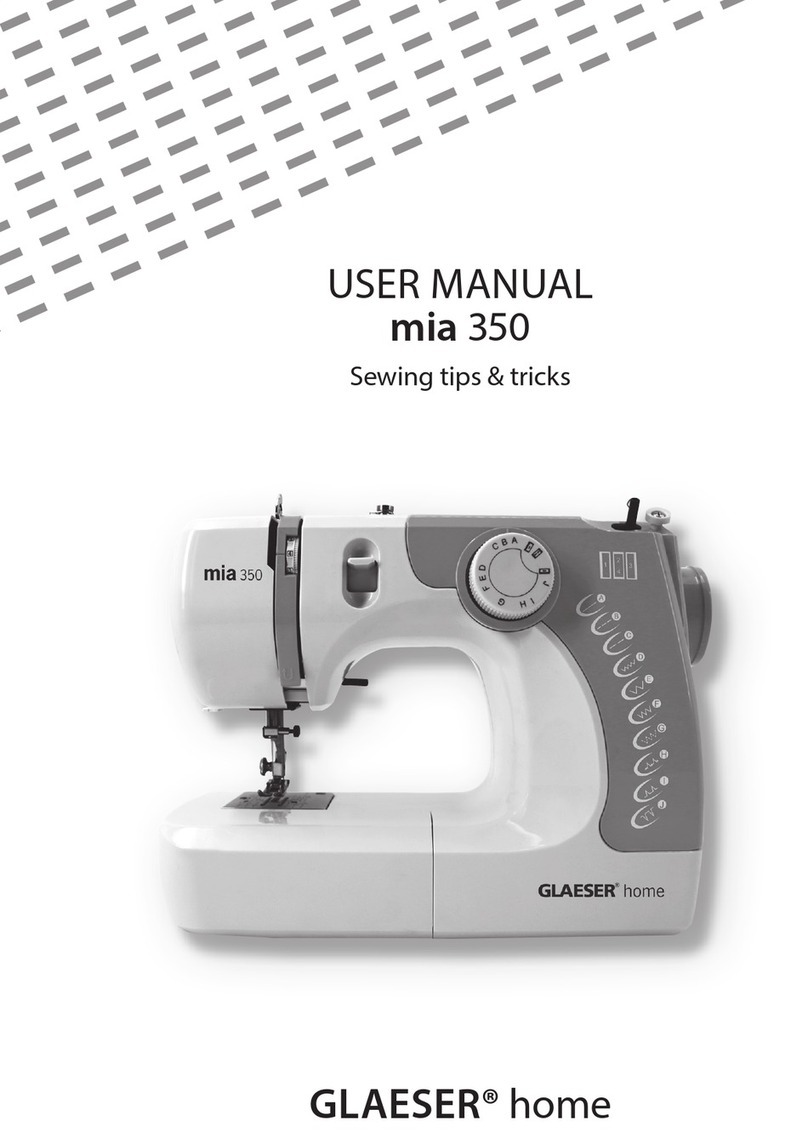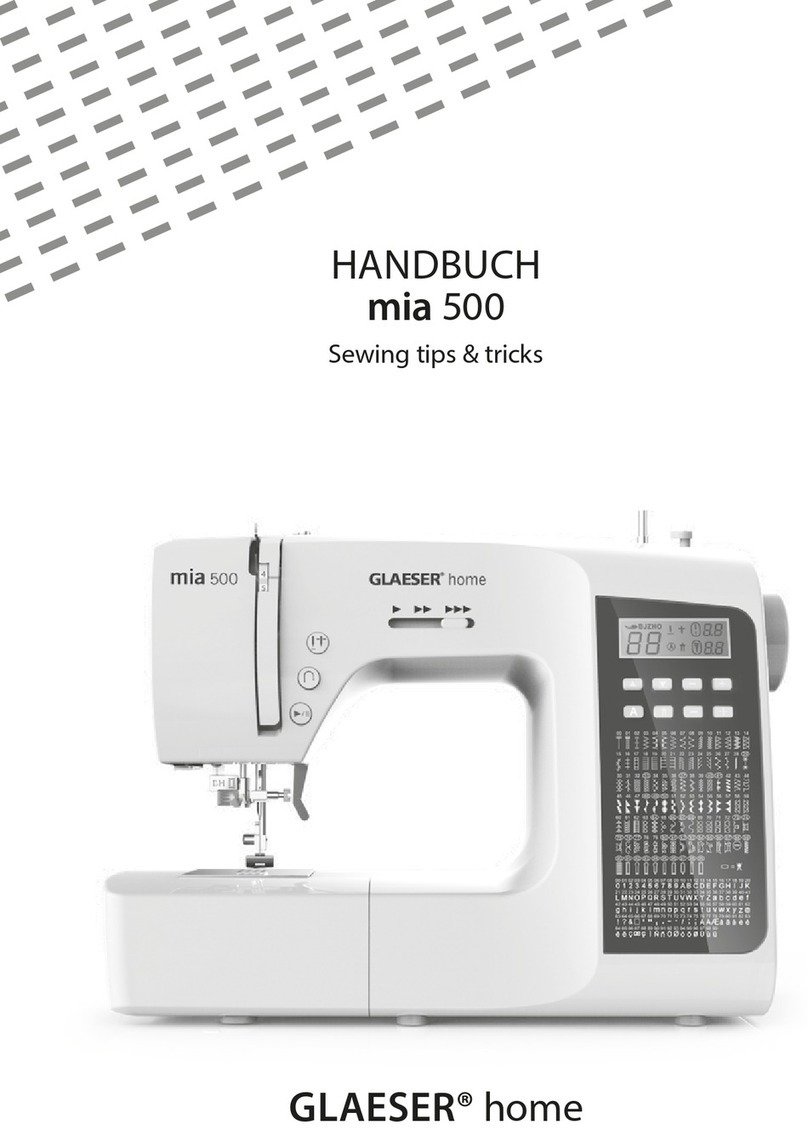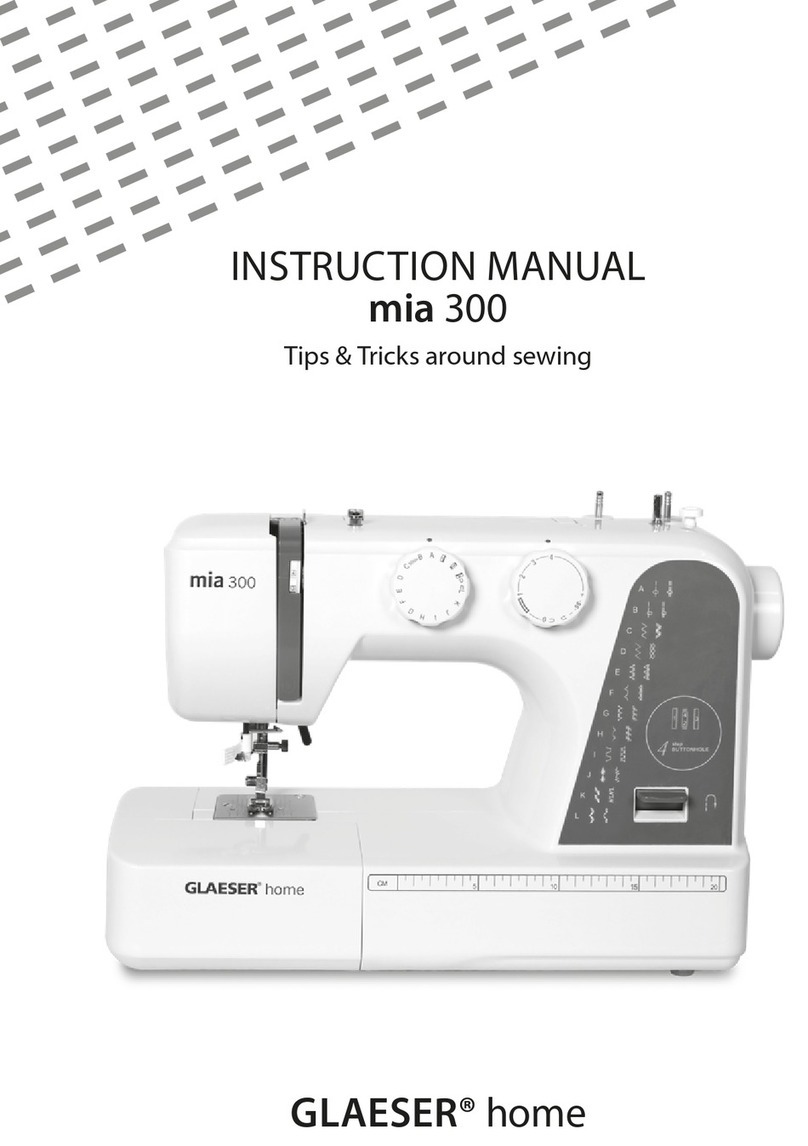Glaeser home ol 50 User manual

INSTRUCTION MANUAL
ol 50
Tips & Tricks around sewing
GLAESER® home

2
IMPORTANT SAFETY INSTRUCTIONS
When using an electrical appliance, basic safety precautions should always be followed, including
the following.
Read all instructions before using this sewing machine.
DANGER – To reduce the risk of electric shock:
1. Do not allow to be used as a toy. Close attention is necessary when this sewing machine is used
by or near children.
2. This appliance can be used by children aged from 8 years and above and persons with reduced
physical, sensory or mental capabilities or lack of experience and knowledge if they have been
given supervision or instruction concerning use of the appliance in a safe way and understand
the hazards involved. Children shall not play with the appliance. Cleaning and user maintenance
shall not be made by children without supervision.
3. Use this sewing machine only for its intended use as described in this manual. Use only attach-
ments recommended by the manufacturer as contained in this manual.
4. Never operate this sewing machine if it has a damaged cord or plug, if it is not working properly,
if it has been dropped or damaged, or dropped into water. Return the sewing machine to the
nearest authorized dealer or service center for examination,repair, electrical or mechanical
adjustment.
5. Never operate the sewing machine with any air openings blocked. Keep ventilation openings of
the sewing machine and foot control free from the accumulation of lint, dust, and loose cloth.
6. Never drop or insert any object into any opening.
7. Do not use outdoors.
8. Do not operate where aerosol (spray) products are being used or where oxygen is being admin-
istered.
9. To disconnect, turn switch to the o (”O”) position, then remove plug from outlet.
10. Do not unplug by pulling on cord. To unplug, grasp the plug, not the cord.
11. Keep ngers away from all moving parts. Special care is required around the sewing machine
needle.
12. Never sew with a damaged needle plate as this can cause needle to break.
13. Do not use bent needles.
14. Do not pull or push fabric while stitching. It may deect the needle causing it to break.
15. Switch the sewing machine o ("0") when making any adjustments in the needle area, such as
threading needle, changing needle, threading bobbin, or changing presser foot, etc.
16. Always unplug sewing machine from the electrical outlet when removing covers, lubricating, or
when making any other user servicing adjustments mentioned in the instruction manual.
17. Attention the following to avoid injury:
· Switch o or unplug the appliance when leaving it unattended;
· Unplug the appliance before carrying out maintenance.

3
CAUTION: Moving parts-To reduce risk of injury, switch o before servicing. Close cover before
operating machine.
SAVE THESE INSTRUCTIONS
This appliance complies with EMC Directive 2014/30/EU covering the electromagnetic compatibility.
Please note that on disposal, this product must be safely recycled in accordance with
relevant National legislation relating to electrical/ electronic products. If in doubt please
contact your retailer for guidance.

4
Table of Contents
Important safety instructions.................................................................................................................2
Specication of machine..........................................................................................................................6
Knowing your machine.............................................................................................................................7
Identication chart.....................................................................................................................................7
Accessories ....................................................................................................................................................8
Setting up your machine..........................................................................................................................9
Preparation for threading......................................................................................................................10
Spool caps for domestic type spools ................................................................................................11
Spool disc and spool holders for cone spools ...............................................................................11
Spool nets....................................................................................................................................................11
Lint tray.........................................................................................................................................................12
Cutting width gauge................................................................................................................................12
Thread cutter..............................................................................................................................................12
Changing presser feet.............................................................................................................................12
Changing needle.......................................................................................................................................13
Needle, thread and fabric chart...........................................................................................................13
Starting to sew...........................................................................................................................................14
Threading your machine........................................................................................................................14
Threading lower looper..........................................................................................................................14
Threading upper looper.........................................................................................................................15
Treading needles.......................................................................................................................................16
Helpful hints................................................................................................................................................17
Replacing thread spools.........................................................................................................................17
Cutting needle thread.............................................................................................................................17
Testing stitch overlock stitches............................................................................................................18
Setting chart ...............................................................................................................................................19
Three-thread overlock with one needle...........................................................................................20
Converting to two-thread use..............................................................................................................20
Narrow and rolled hem, picot stitch ..................................................................................................21
Recommended thread............................................................................................................................22
Adjusting thread tensions .....................................................................................................................22

5
Two-thread use ..........................................................................................................................................22
Four-thread use .........................................................................................................................................23
Adjusting stitch length ...........................................................................................................................24
Adjusting overedge cutting width.....................................................................................................24
Dierential feed.........................................................................................................................................25
Positive dierential feed.........................................................................................................................25
Negative dierential feed......................................................................................................................25
Setting dierential feed..........................................................................................................................26
Sewing with extra heavyweight fabric or multiple layers of fabric .......................................26
Foot pressure regulator ..........................................................................................................................26
Basic techniques........................................................................................................................................27
Turning outside corners without cutting threads ........................................................................27
Removing stitches from sewn fabric .................................................................................................27
Corded overlock ........................................................................................................................................28
Decorative eects.....................................................................................................................................29
Dierential feed applications...............................................................................................................30
Caring for your machine.........................................................................................................................31
Replacing moving cutter........................................................................................................................31
Disengaging moving cutter..................................................................................................................31
Cleaning and oiling ..................................................................................................................................32
Checking performance problems.......................................................................................................33
Table of contents
Other Glaeser home Sewing Machine manuals




















